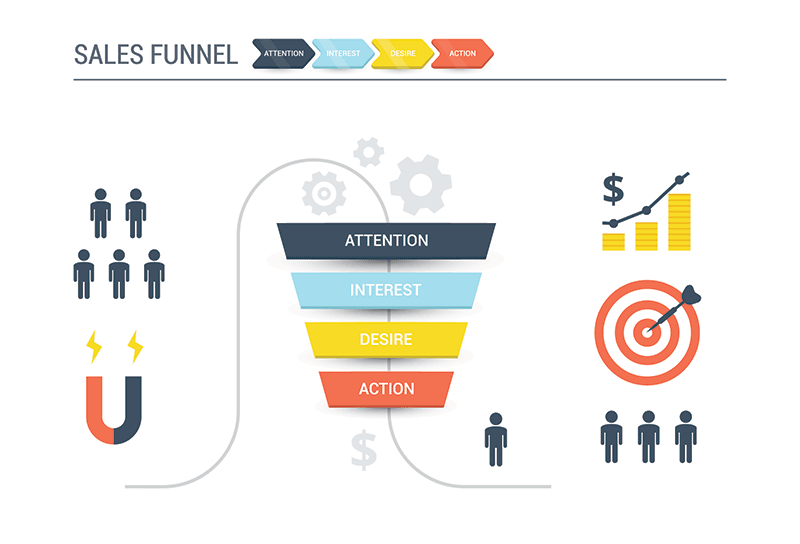Ecommerce has exploded to be the premier way some of the most successful businesses are generating revenue. To that end, eCommerce giants like Amazon posted record rakes of roughly 178 billion dollars in 2017 alone.
Combine that number with what other eCommerce companies like eBay do and you’ll start to make out the chunk of the world economy eCommerce is responsible for.
So, as a business owner, how can you get in on the money that’s out there in the eCommerce space? Maybe you’ve launched a website, opened up an online store, and started selling.
But are you maximizing the potential of your eCommerce business?
One of the best ways to up your eCommerce game is via eCommerce tracking. The process of analyzing key sales-related metrics.
Our team at Cheeky Monkey Media is here to give you the rundown on 7 top metrics to keep an eye on!
1) Sales Conversions
A business is only as successful as the number of sales it’s able to generate. On that note, understanding the sales conversion rate of your website is key to knowing the overall effectiveness of your marketing efforts.
This number is relatively easy to calculate.
You just need to start by knowing how many visitors come to your site during a given month. Let’s say 100 for example’s sake. Then, you need to know how many sales you’ve made in the same month, let’s say 10.
Take your 10 sales and divide them by your 100 visitors (.1). Multiply that result by 100%. Your sales conversion rate would be 10%.
That means that for every 100 customers that visit your website, 10% of them are buying your products.
Staying mindful of how that figure fluctuates from month to month and what factors may have caused that fluctuation (promotions for example) is key in determining what works to improve sales.

2) Customer Volume per Traffic Source
How you’re getting leads to your website is an important metric to stay mindful of. It informs you where your efforts are best spent so you can tailor your marketing to those platforms. It also can help you determine if you need to double down on a weaker lead source you feel has more potential.
This metric can be tracked easily through your Google analytics dashboard. Look at your visitors for the month and where they came from. Then, boil down each traffic source to a percentage.
So if you have 100 visitors in a month and 5 came from Facebook, you know that Facebook brings you 5% of your customers.
3) Email Opt-in Performance
 Email marketing is an excellent, low-cost way to market to customers both existing and potential. It’s also a good way to reactivate people who have purchased from you in the past but haven’t recently.
Email marketing is an excellent, low-cost way to market to customers both existing and potential. It’s also a good way to reactivate people who have purchased from you in the past but haven’t recently.
To maximize your email marketing efforts, it’s important to notice the degree to which people are opting in.
Your mailing list provider should provide you with daily, weekly, or monthly subscriber changes. Pay attention to those numbers!
They can let you know if adjustments to your sign-up form, new content you published, etc. are affecting your subscriber counts.
4) Repeat Purchase Likelihood
Did you know that just 32% of new customers in the eCommerce space place a second order with a company on average?
Understanding if your eCommerce business falls above or below that trend is important to determine how to tailor your marketing efforts.
To determine this eCommerce tracking metric, look at the number of your customers who have shopped with you more than once. Then, divide that by the total amount of customers who have shopped with you.
That will give you your repeat purchase rate.
If your repeat purchase rate feels low, leveraging marketing tactics like email to entice one-time shoppers to shop again can be very effective!
5) Customer Acquisition Costs
This metric can be daunting for some businesses to track but it’s incredibly important! It informs you if your marketing expenses are too high for the results they’re delivering.
To understand your customer acquisition cost, divide the number of customers you get by your annual marketing spend.
For example, if you spent $10,000 last year in marketing and got 400 new customers as a result, each of your customers costs you $25.00.
6) Your Customer’s Lifetime Value
This metric goes hand in hand with your customer acquisition costs.
Why?
Because you need to be able to determine if your cost to get customers is less than the value they represent to your business.
To understand your customer’s lifetime value, you have to mine some average customer insight. Ask yourself, how often does my average customer buy from me? What is the average amount they spend on each transaction?
Say, as a result of your investigation, you find out that your average customer spends $15.00 each transaction and buys 10 times a year. That means that each time you acquire a customer for $25.00, you get $150.00 per year for your trouble.
7) Profit Per Visitor
This is another fun eCommerce tracking metric to follow. It enables you to understand how much money you’re profiting every time someone lands on your webpage!
To calculate this, just take the profit your business got during a single month and divide it by the amount of traffic you received.
Over time, you can keep building on this figure by adding more data which will eventually lead to a stable profit per visitor ratio! This number will help inform your marketing spend ensuring that you’re not investing too much in getting people to your site.
Wrapping Up Important Ecommerce Tracking Metrics
Data is a massive driver of successful eCommerce. The more you know about your customers, the better you can tailor your efforts to maximize the value they represent to you.
Our recommendation – Start with some of the eCommerce tracking metrics we mentioned above that you feel most comfortable with. Once you’ve mastered tracking and mining intel from them, add more to your routine!
If you’re a business owner or decision maker looking to maximize your eCommerce potential, Cheeky Monkey Media has solutions for you.
Cheeky Monkey Media is a full-service web design, marketing, and SEO firm. We specialize in helping companies like yours scale elegantly and rapidly!
Check out everything we can offer you today!





